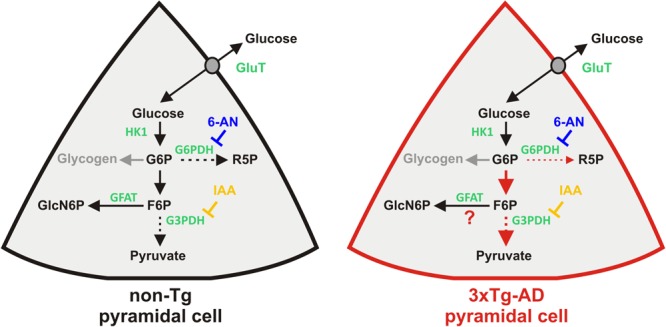FIGURE 7.

Resting glucose metabolism of juvenile pyramidal cells and its alterations in 3xTg-AD mice. Glucose uptake is facilitated via glucose transporters (GluT). Once in the cytoplasm glucose phosphorylation by Hexokinase1 (HK1) yields to glucose 6-phosphate (G6P), the common substrate of different metabolic pathways. Glucose-6-phosphate dehydrogenase (G6PDH) is the rate limiting enzyme of the pentose phosphate pathway leading to ribose-5-phosphate (R5P). Pentose phosphate pathway is blocked by the G6PDH inhibitor, 6-aminonicotinamide (6-AN). G6P can also be isomerized into fructose-6-phosphate (F6P), a common intermediate of the glycolysis and the hexosamine biosynthetic pathway. Glycolysis is blocked by Iodoacetic acid (IAA) inhibiting glyceraldehyde-3-phosphate dehydrogenase (G3PDH). Glutamine:fructose-6-phosphate amidotransferase (GFAT), the rate limiting enzyme of the hexosamine biosynthetic pathway, converts fructose-6-phosphate and glutamine into glucosamine-6-phosphate (GlcN6P) and glutamate (glutamine and glutamate are omitted for the sake of simplicity). G6P is also the precursor of glycogen whose synthesis is normally absent in neurons (gray arrow). Dashed arrows indicate multisteps reactions. Functional changes in 3xTg-AD neurons are depicted by red arrows. Thicker and thinner arrows denote increased and decreased pathways, respectively.
